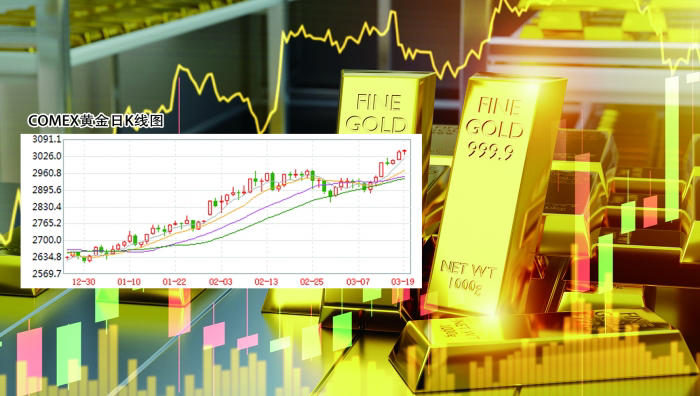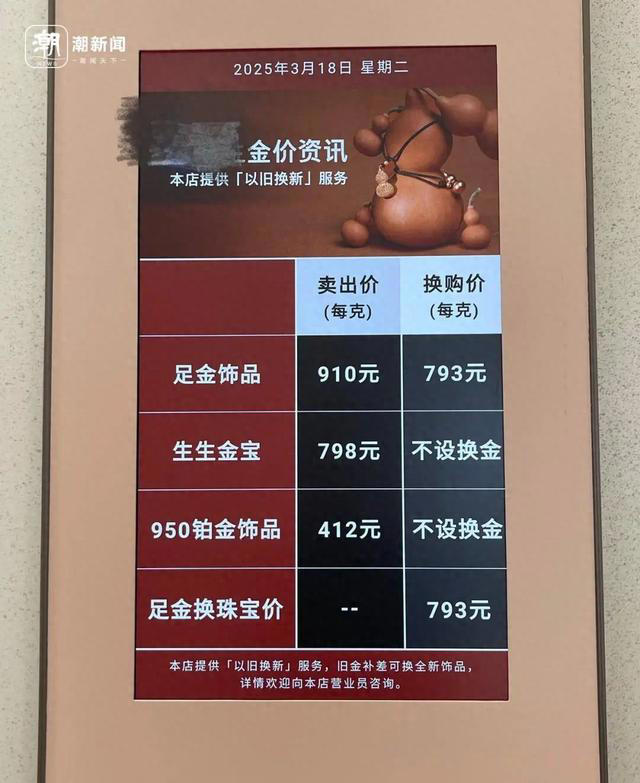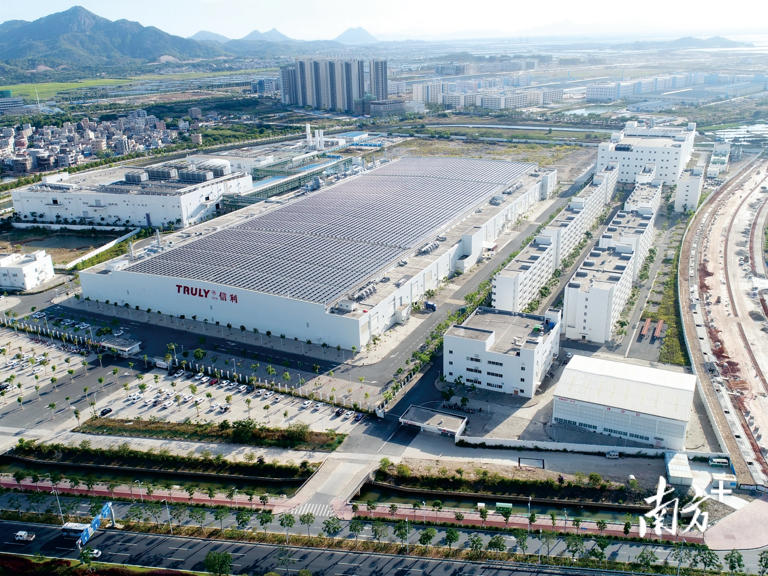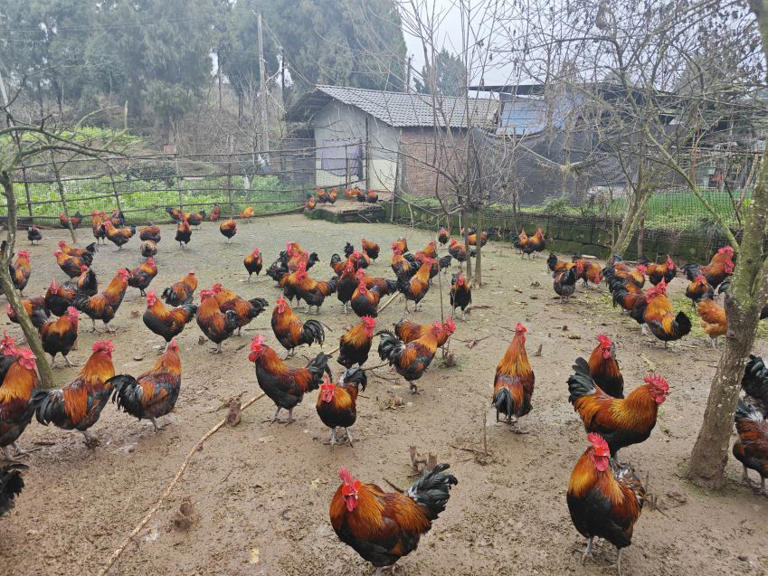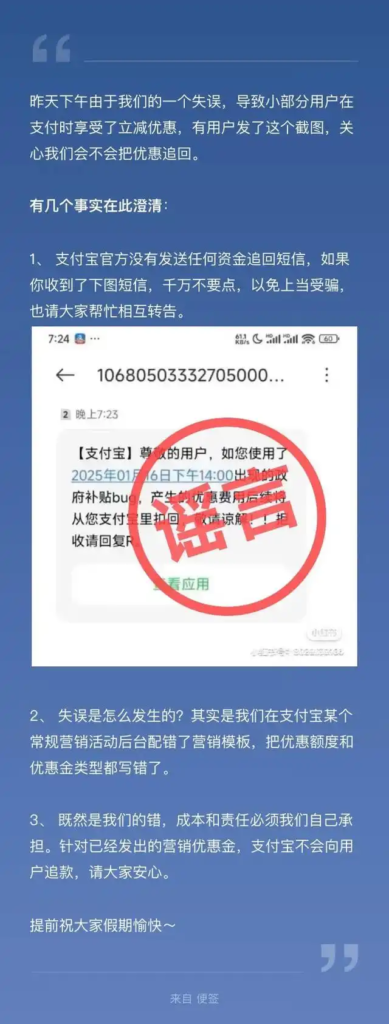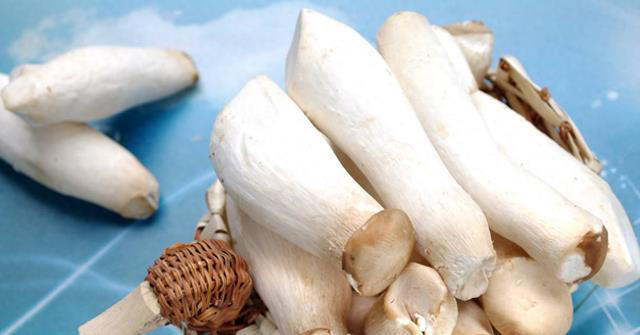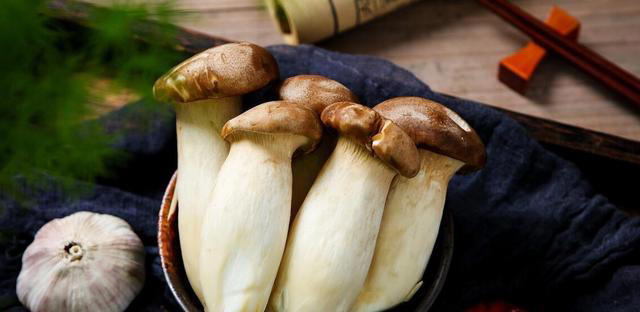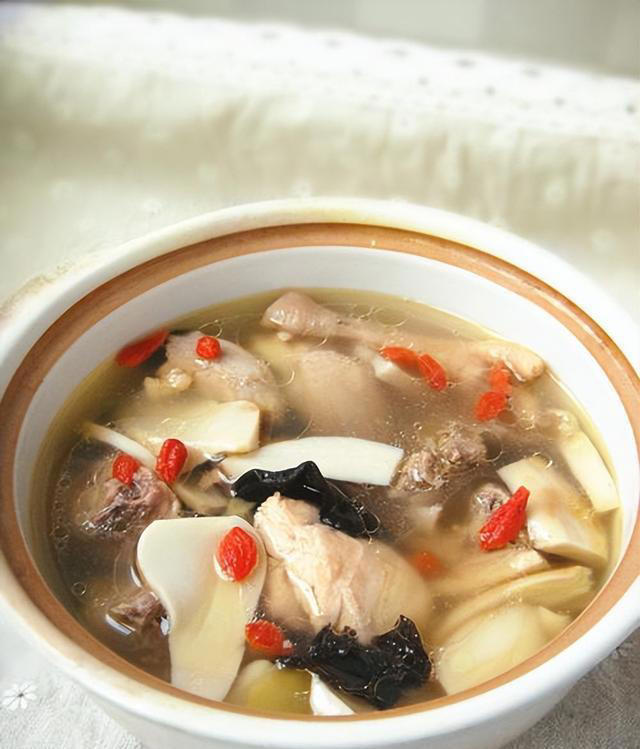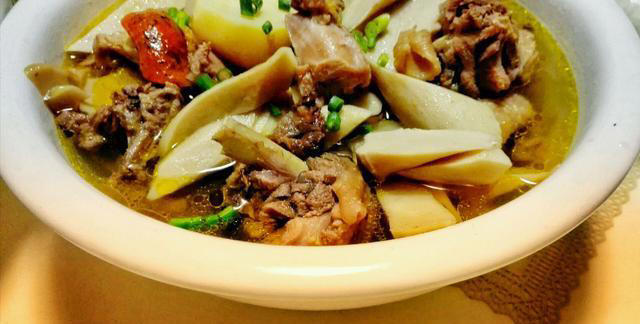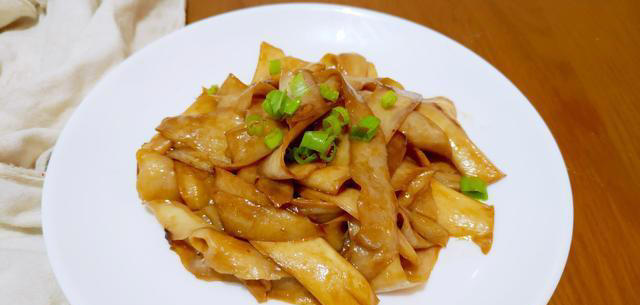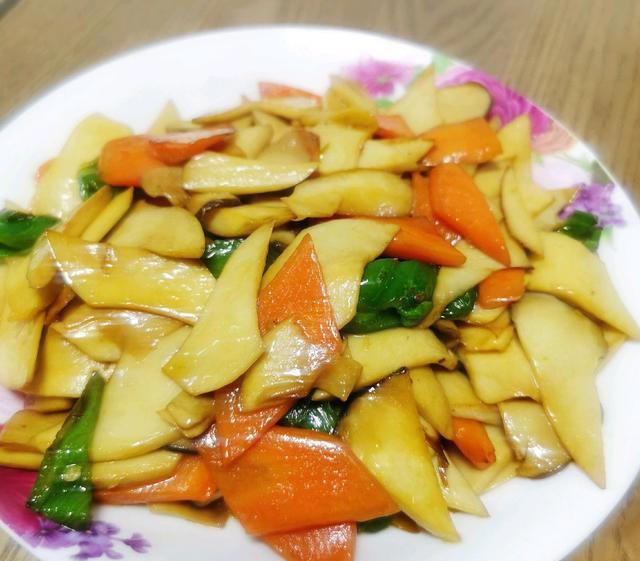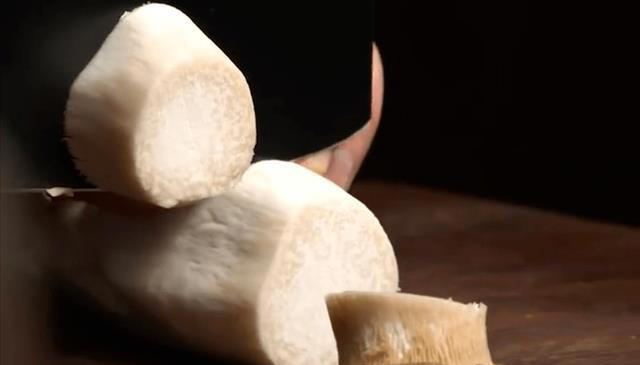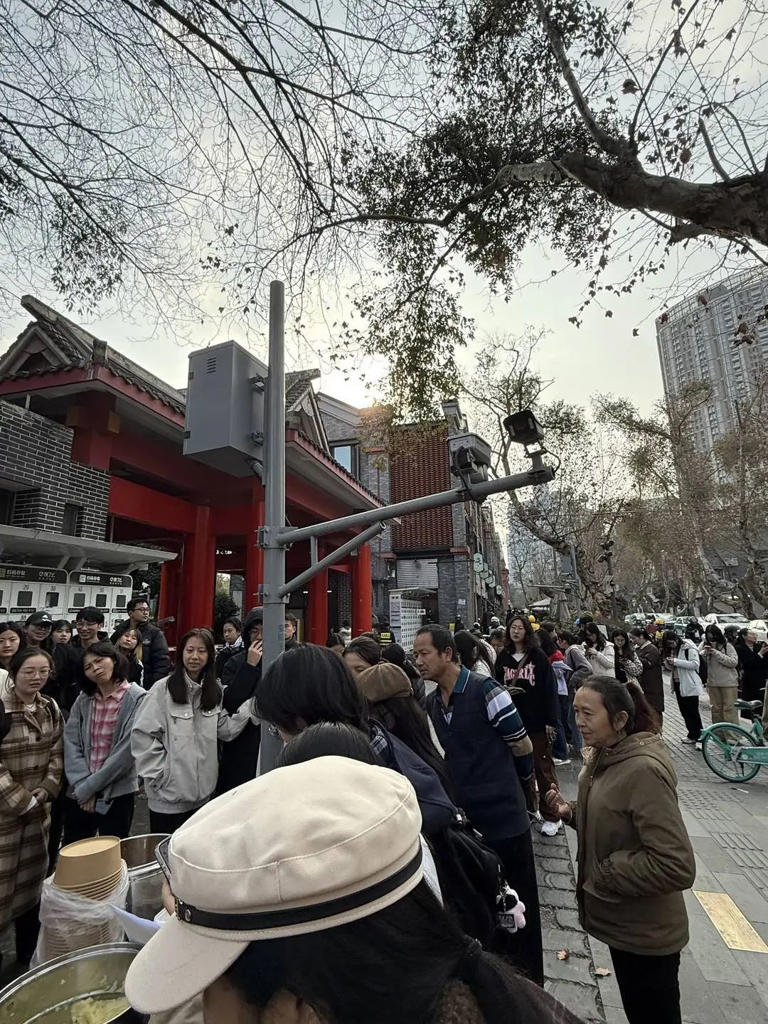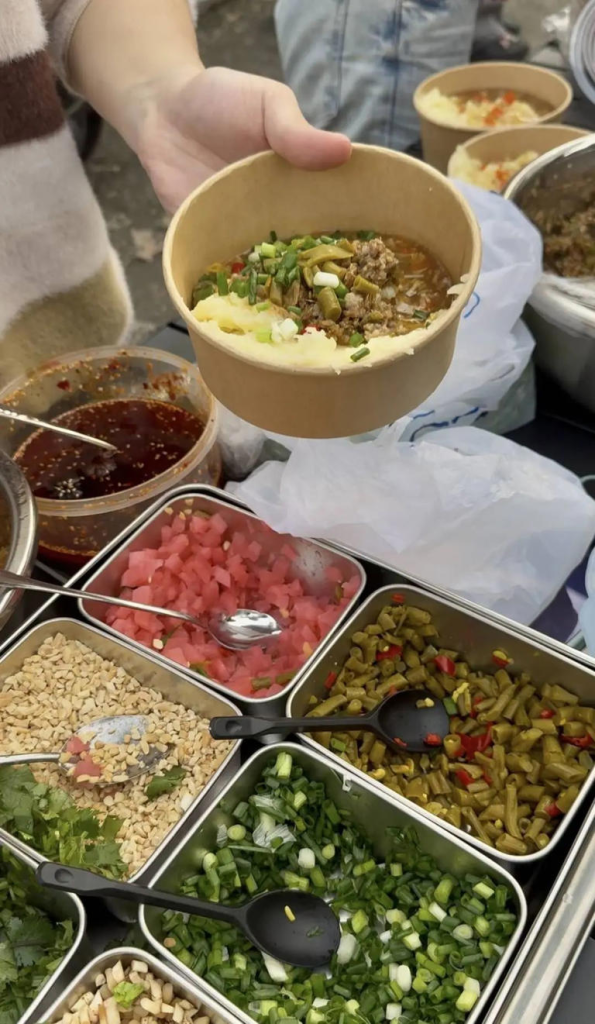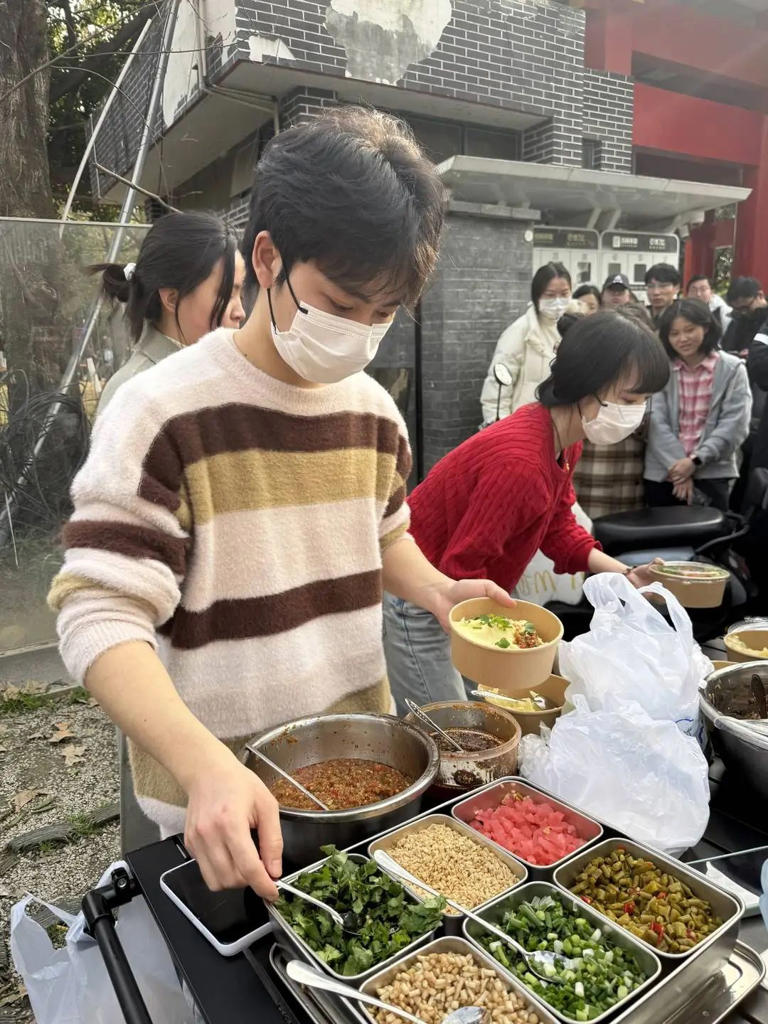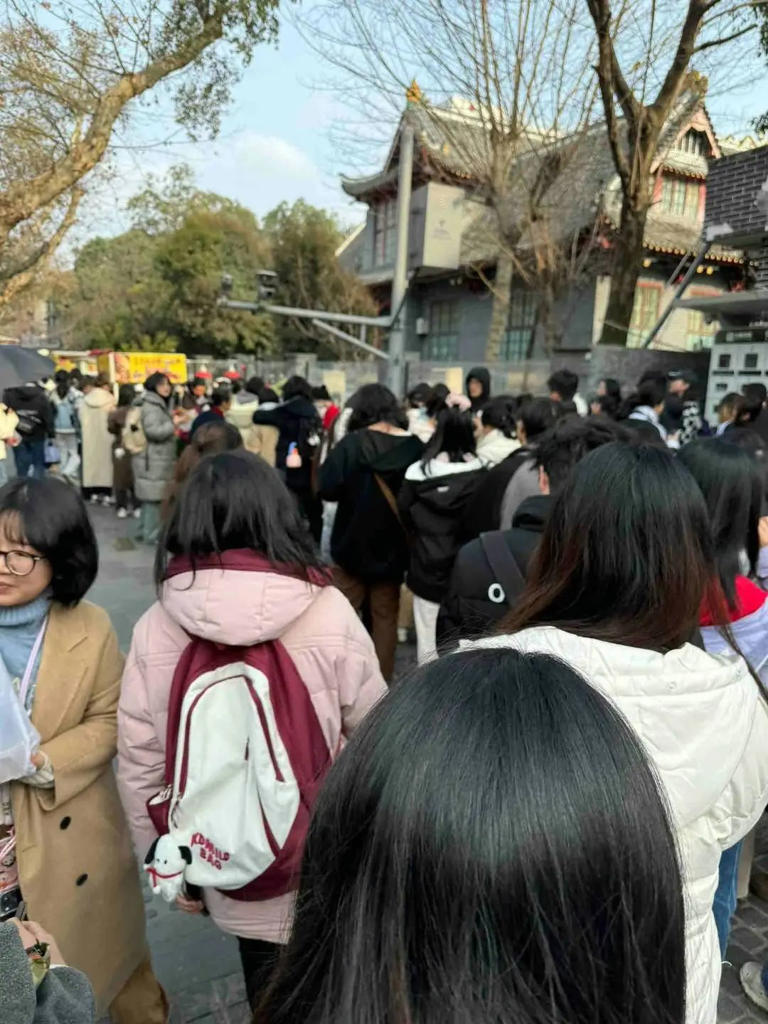On February 9, the National Bureau of Statistics released the national CPI (Consumer Price Index) and PPI (Industrial Producer Price Index) data for January 2025.
CPI rose 0.5% year-on-year
In January 2025, the national consumer price rose by 0.5% year-on-year. Among them, the urban area increased by 0.6%, and the rural area increased by 0.3%; Food prices rose by 0.4% and non-food prices by 0.5%; Consumer goods prices rose by 0.1 per cent and services by 1.1 per cent.
In January, the national consumer price rose by 0.7% month-on-month. Among them, the urban area rose by 0.8%, and the rural area increased by 0.5%; Food prices rose by 1.3% and non-food prices by 0.6%; Consumer goods prices rose by 0.6 per cent and services by 0.9 per cent.
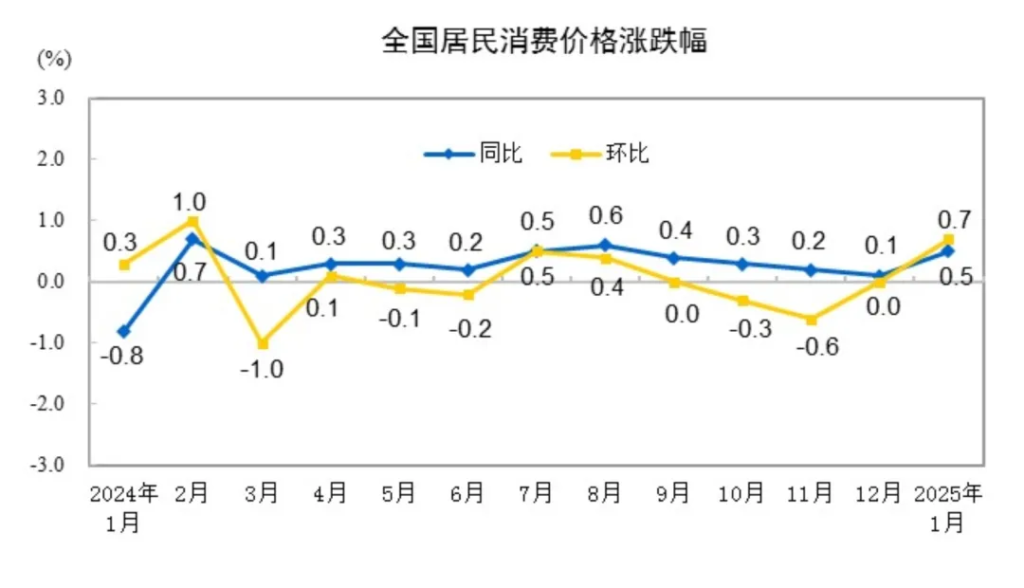
1. Year-on-year changes in the prices of various commodities and services
In January, the prices of food, tobacco and alcohol rose by 0.6% year-on-year, affecting the CPI (consumer price index) to rise by about 0.16 percentage points. Among the foodstuffs, the price of livestock and meat rose by 2.5%, affecting the CPI by about 0.08 percentage points, of which the price of pork rose by 13.8%, affecting the CPI by about 0.17 percentage points, the price of fresh vegetables rose by 2.4%, affecting the CPI by about 0.05 percentage points, the price of aquatic products rose by 1.2%, affecting the CPI by about 0.02 percentage points, and the price of fresh fruits rose by 0.6%. The impact of the CPI increase was about 0.01 percentage points, and the decline in food prices by 1.4% affected the CPI by about 0.03 percentage points.
The prices of the other seven categories rose five times year-on-year and fell two times. Among them, the prices of other goods and services, education, culture and entertainment, and clothing increased by 5.4%, 1.7% and 1.1% respectively, and the prices of medical care and housing increased by 0.7% and 0.1% respectively. Prices of daily necessities and services, transportation and communications fell by 1.1% and 0.6% respectively.
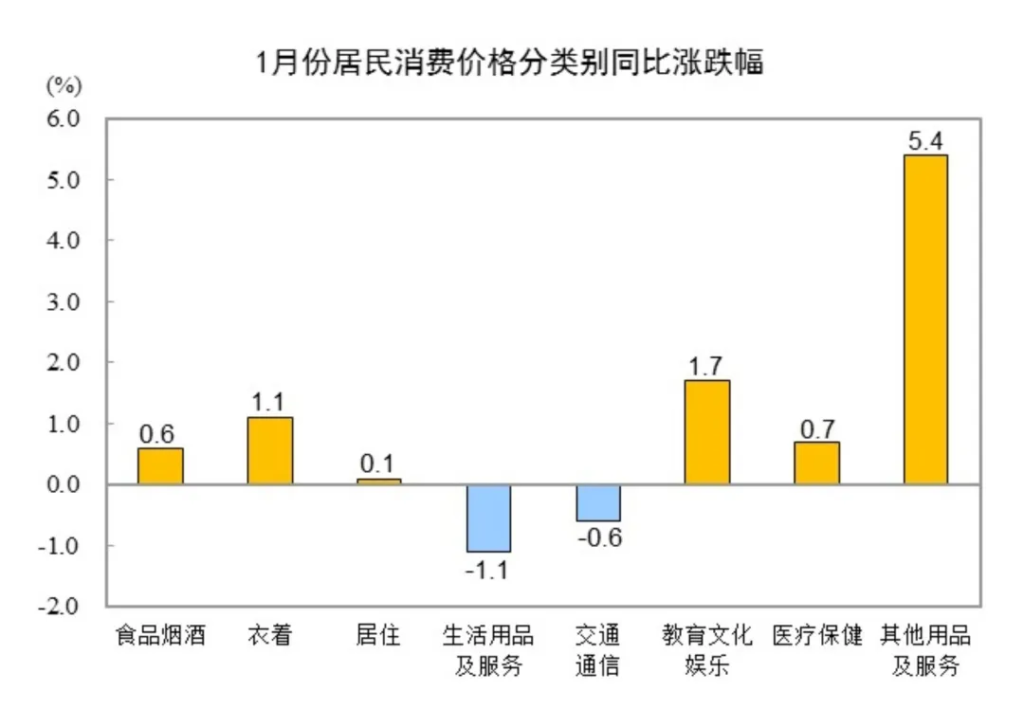
2. Month-on-month changes in the prices of various goods and services
In January, the prices of food, tobacco and alcohol rose by 0.9% month-on-month, affecting the CPI to rise by about 0.26 percentage points. Among the foodstuffs, the price of fresh vegetables rose by 5.9%, affecting the CPI by about 0.12 percentage points, the price of fresh fruits rose by 3.3%, affecting the CPI by about 0.07 percentage points, the price of aquatic products rose by 2.7%, affecting the CPI by about 0.05 percentage points, and the price of livestock and meat rose by 0.4%, affecting the CPI by about 0.01 percentage points, of which the price of pork rose by 1.0%, affecting the CPI by about 0.01 percentage points.
The prices of the other seven categories rose four times month-on-month, two flat and one decreased. Among them, the prices of transportation and communications, other goods and services increased by 1.7% and 1.6% respectively, and the prices of education, culture and entertainment, daily necessities and services increased by 1.5% and 0.7% respectively; Housing and health care prices are flat; Clothing prices fell by 0.4 per cent.
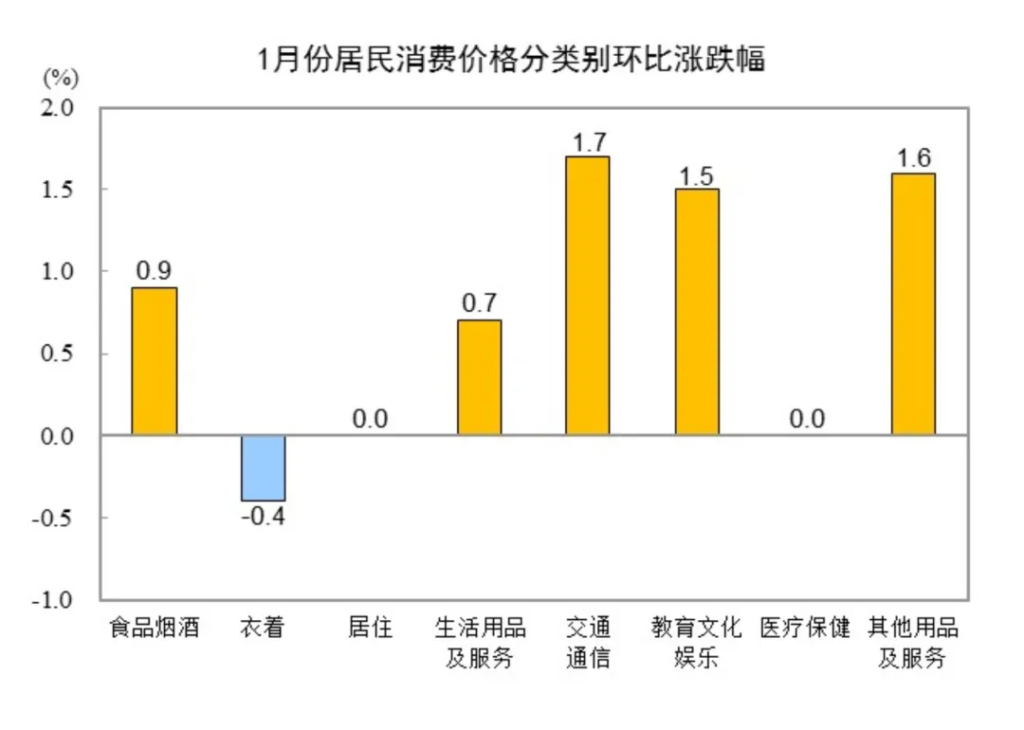
PPI fell 2.3% year-on-year
In January 2025, the ex-factory prices and purchase prices of industrial producers across the country both fell by 2.3% year-on-year, the same rate as the previous month; Both decreased by 0.2% month-on-month.
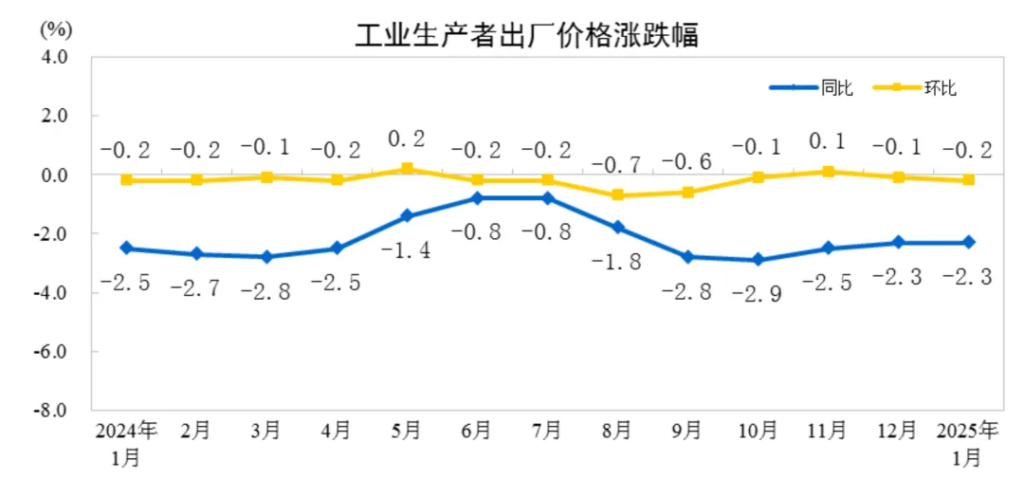

1. Year-on-year changes in industrial producer prices
In January, among the ex-factory prices of industrial producers, the prices of means of production fell by 2.6 percent, affecting the overall level of ex-factory prices of industrial producers by about 1.95 percentage points. Among them, the prices of extractive industries decreased by 4.9 percent, the prices of raw materials industries decreased by 1.9 percent, and the prices of processing industries decreased by 2.7 percent. The prices of means of subsistence fell by 1.2 percent, affecting the overall level of ex-factory prices of industrial producers by about 0.31 percentage points. Among them, the price of food decreased by 1.4 percent, the price of clothing decreased by 0.1 percent, the price of general daily necessities rose by 0.5 percent, and the price of durable consumer goods decreased by 2.6 percent.
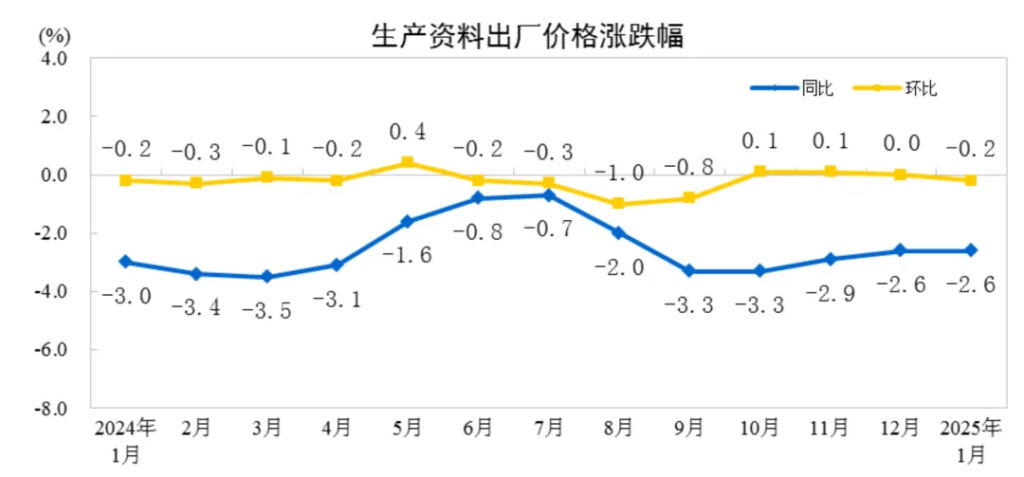
Among the purchase prices of industrial producers, the prices of ferrous metal materials decreased by 8.9 percent, the prices of fuel and power decreased by 5.2 percent, the prices of chemical raw materials decreased by 4.1 percent, the prices of agricultural and sideline products decreased by 3.3 percent, the prices of building materials and non-metals decreased by 2.3 percent, and the prices of textile raw materials decreased by 1.4 percent. The price of non-ferrous metal materials and wires rose by 10.9%.
2. Month-on-month changes in industrial producer prices
In January, among the ex-factory prices of industrial producers, the prices of means of production fell by 0.2 percent, affecting the overall level of ex-factory prices of industrial producers by about 0.17 percentage points. Among them, the prices of the extractive industry fell by 0.2%, the prices of the raw materials industry were flat, and the prices of the processing industry decreased by 0.3%. The price of means of subsistence was flat. Among them, the price of food decreased by 0.2%, the price of clothing decreased by 0.2%, the price of general daily necessities decreased by 0.1%, and the price of durable consumer goods rose by 0.2%.
Among the purchase prices of industrial producers, the prices of agricultural and sideline products decreased by 0.4 percent, the prices of ferrous metal materials decreased by 0.3 percent, the prices of chemical raw materials and textile raw materials decreased by 0.2 percent, and the prices of fuel power, non-ferrous metal materials and wires, building materials and non-metals decreased by 0.1 percent.
Experts: Prices for services and food are rising
It is the main factor in the rise of CPI
In this regard, Dong Lijuan, chief statistician of the Urban Department of the National Bureau of Statistics, interpreted.
First, the CPI increase expanded
In January, affected by the Spring Festival, the national CPI increase expanded, from the previous month’s flat to 0.7%, and the year-on-year increase expanded from 0.1% in the previous month to 0.5%. Core CPI, which excludes food and energy prices, rebounded for the fourth consecutive month, rising 0.5% month-on-month and 0.6% year-on-year, both of which were larger than the previous month.
From a month-on-month perspective, rising service and food prices are the main factors affecting the CPI from flat to rising month-on-month. Service prices rose by 0.9%, an increase of 0.8 percentage points over the previous month, affecting the CPI to rise by about 0.37 percentage points month-on-month, accounting for more than half of the total CPI increase. Among the services, the demand for travel and entertainment consumption increased significantly during the Spring Festival, with the prices of air tickets, transportation rental fees, tourism, movies and performance tickets increasing by 27.8%, 16.0%, 11.6% and 9.6% respectivelyThe CPI rose by about 0.28 percentage points month-on-month, and the prices of domestic services and hairdressing rose by 9.3% and 9.2% respectively due to the return of migrant workers and the increase in demand for services. Food prices rose by 1.3%, affecting the CPI to rise by about 0.24 percentage points month-on-month, accounting for more than 30% of the total CPI increase. Among the foodstuffs, the prices of fresh vegetables, fresh fruits and aquatic products increased by 5.9%, 3.3% and 2.7% respectively due to the impact of the Spring Festival and the drop in temperature. In addition, affected by the rise in international gold and crude oil prices, domestic gold jewelry and gasoline prices rose by 3.0% and 2.5% respectively, which together affected the CPI to rise by about 0.10 percentage points month-on-month.
From a year-on-year perspective, the prices of services and food increased significantly due to the staggered month of the Spring Festival, coupled with the rebound in gasoline prices, which jointly affected the year-on-year increase in CPI. Service prices rose by 1.1%, an increase of 0.6 percentage points from the previous month, affecting the CPI to rise by about 0.42 percentage points year-on-year, higher than the previous month by 0.22 percentage points. Among services, air tickets and travel prices increased by 8.9% and 7.0% respectively; Prices for movie and performance tickets, housekeeping services and hairdressing rose by 11.0%, 6.9% and 5.8% respectively。 Food prices rose by 0.4%, affecting the CPI to rise by about 0.07 percentage points year-on-year, and the CPI fell by about 0.09 percentage points last month. Among the foodstuffs, the prices of pork and fresh vegetables rose by 13.8% and 2.4% respectively, totaling the CPI up by about 0.22 percentage points year-on-year, while the prices of beef, mutton, edible oil and grain decreased by 13.1%, 5.6%, 2.5% and 1.4% respectively, affecting the CPI by about 0.15 percentage points year-on-year. The price of industrial consumer goods fell by 0.2%, of which the decline in gasoline prices narrowed to 0.6% from 4.0% in the previous month, and the downward impact on the CPI was 0.12 percentage points lower than that of the previous month; in addition, the prices of fuel cars and new energy cars fell by 4.6% and 5.8% respectively, and the price of gold jewelry rose by 30.0%.
It is estimated that in the 0.5% year-on-year change in CPI in January, the carryover effect is about -0.2 percentage points, and the new impact of price changes this year is about 0.7 percentage points.
Second, PPI fell year-on-year
In January, affected by factors such as the Spring Festival holiday, industrial production was in the off-season, and the national PPI fell by 0.2% month-on-month and 2.3% year-on-year.
On a month-on-month basis, PPI fell by 0.2%, an increase of 0.1 percentage points from the previous month. Among them, the price of means of production decreased by 0.2% from the flat level in the previous month; Prices of means of subsistence remained flat from a 0.1% decline in the previous month. During the Spring Festival, the supply of coal was strong, the coal storage of power plants was relatively sufficient, and the price of coal mining and washing industry fell by 2.2%. Affected by factors such as holidays and low temperature weather, real estate and infrastructure projects were partially suspended, and the demand for building materials and other materials fell, the price of ferrous metal smelting and rolling processing industry fell by 0.9%, and the price of non-metallic mineral products industry fell by 0.6%. Affected by the fluctuation of international non-ferrous metal prices, the domestic non-ferrous metal smelting and rolling processing industry prices fell by 0.4%. The rise in international crude oil prices drove up the prices of domestic oil-related industries, of which the prices of oil and gas extraction rose by 4.5%, and the prices of petroleum, coal and other fuel processing industries rose by 1.0%. In the equipment manufacturing industry, the manufacturing price of computer machines decreased by 0.7%, and the manufacturing price of lithium-ion batteries decreased by 0.6%; Aircraft manufacturing prices rose by 1.1 percent, gasoline and diesel vehicle manufacturing prices rose by 0.8 percent, and photovoltaic equipment and components manufacturing prices rose by 0.5 percent. In the consumer goods manufacturing industry, the prices of agricultural and sideline food processing industries decreased by 0.5 percent, and the prices of textile industries decreased by 0.4 percent; The price of the manufacturing of cultural, educational, articular, sports and recreational goods rose by 0.3 percent, and the price of paper and paper products rose by 0.2 percent.
On a year-on-year basis, PPI fell by 2.3%, the same rate of decline as the previous month. Among them, the price of means of production fell by 2.6%, the same rate as the previous month; The price of means of subsistence fell by 1.2 percent, 0.2 percentage points narrower than the previous month. By industry, the price of non-ferrous metal mining and dressing industry rose by 18.9 percent, the price of non-ferrous metal smelting and rolling processing industry rose by 9.3 percent, and the price of cultural, educational, articular, sports and recreational goods manufacturing industry rose by 6.7 percent. Among the industries where prices fell, ferrous metal smelting and rolling processing industry decreased by 10.7%, coal mining and washing industry decreased by 10.1%, petroleum, coal and other fuel processing industry decreased by 6.2%, chemical raw materials and chemical products manufacturing industry decreased by 4.0%, automobile manufacturing decreased by 3.1%, non-metallic mineral products industry decreased by 3.0%, computer communication and other electronic equipment manufacturing industry decreased by 1.8%, textile industry decreased by 1.7%, and electrical machinery and equipment manufacturing decreased by 1.6%. The oil and gas extraction industry fell by 1.3%, and the total impact of the above 10 industries on PPI fell by about 2.11 percentage points year-on-year, more than ninety percent of the total decline.
It is estimated that in the 2.3% year-on-year decline in PPI in January, the carryover effect was about -2.1 percentage points, and the new impact of this year’s price changes was about -0.2 percentage points.

 Entering China
Entering China